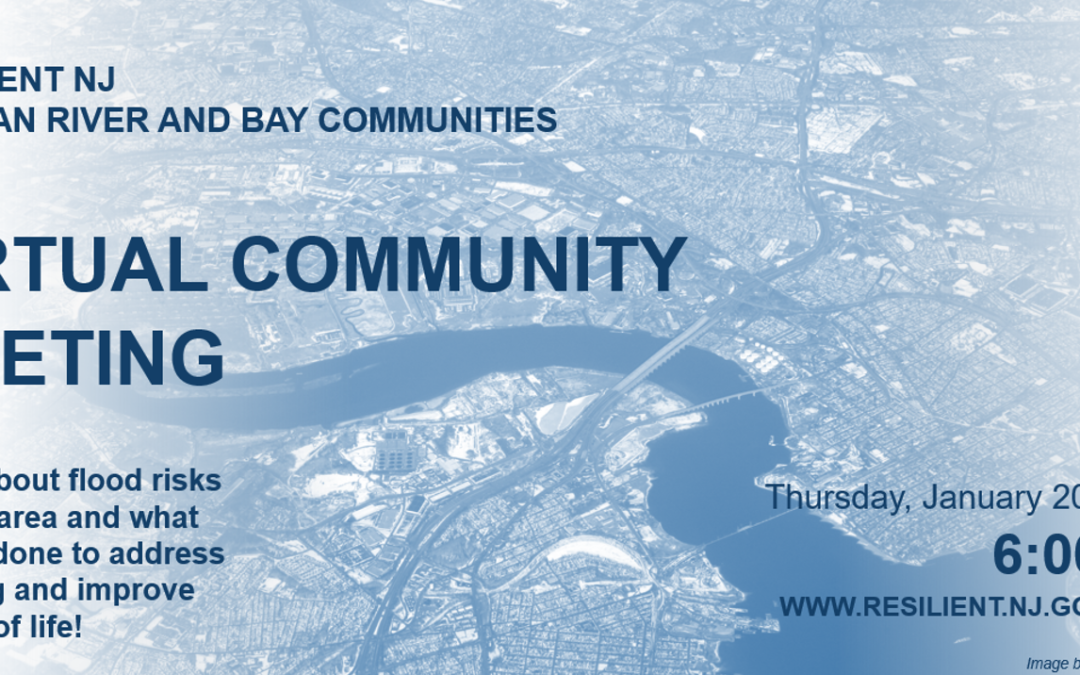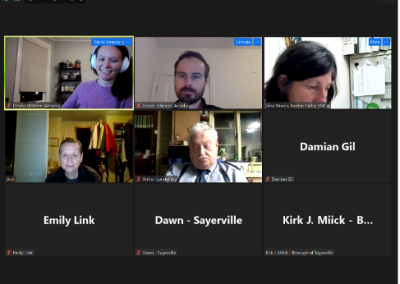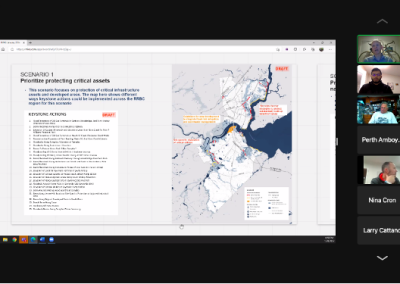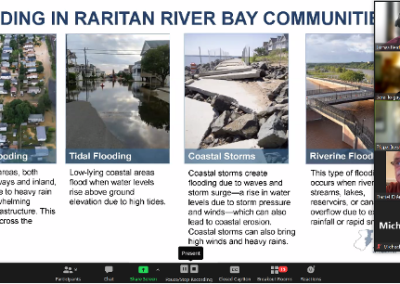Our second Community Meeting was held on January 20th, 2022 to advance the regional resilience action plan to reduce flood risks in Raritan River and Bay Communities: Carteret, Old Bridge, Perth Amboy, Sayreville, South Amboy, South River, and Woodbridge. The project team gave a presentation on flood risk and potential scenarios for flood risk reduction and community members joined breakout sessions to discuss what areas at risk of flooding they are most concerned about, issues beyond flooding they would like to address, and the types of actions they would like to see to reduce flood risk.
The meeting was held from 6:00PM – 7:30PM and included live American Sign Language and Spanish interpretation.
What did we hear?
All the feedback that we received at the Community Meeting is compiled in this virtual board. We invite you to explore the board and add your feedback! Instructions for adding comments are at the top of the board.
Here’s a summary of what we heard, by topic. If you feel that we’ve missed anything or got something wrong, we encourage you to let us know by emailing ResilientRRBC@dep.nj.gov or calling 732-661-3808.
We heard many stories about the impacts of flooding and preferred solutions to reducing flood risk.
Read about these experiences in our virtual board.
Screenshots of the community meeting breakout room discussions
What areas and places at risk from flooding are you most concerned about?
- Across the region, there is a great concern for flooding and numerous locations where repetitive flooding has been witnessed by community members. Flooding is a serious problem and will only worsen with climate change. We heard site-specific examples of where flooding has been a recurring issue and potential ideas to solve the issue
- In Woodbridge and Carteret, flooding has been a recurring issue in different areas of town, such as Middlesex Avenue and Home Depot, under Route 27 and there is a desire for a strategy to reduce flooding there.
- In Perth Amboy and South Amboy, there is repetitive flooding along State Street and elevated levels at the nearby creek, as well as flooding along roads that lack curbs.
- In Sayreville, South River and Old Bridge, there is a concern about next steps after homes are acquired or elevated. There was a concern over emergency vehicle access to roads and evacuation routes (Route 35), particularly to elevated sites. There was interest in protecting new development through nature-based solutions.
- Overall, there was an interest in protecting critical infrastructure, vulnerable populations, and increasing stormwater management for the region.
What additional issues beyond flooding should we seek to address?
- While addressing flooding, there is also an opportunity to address other issues – such as improving waterfront access, enhancing green spaces, and making sure the most vulnerable populations are included in all decision-making.
- There was an interest in projects that will have multiple benefits, such as a waterfront walkway, which would improve quality of life overall.
What types of actions do you want to see to reduce flood risks?
- Homeowners expressed an interest in gaining more information on flood insurance and how to reduce the cost of flood insurance. We heard from homeowners who have dealt with flooding on a recurring basis that there is need for more immediate actions as many existing programs, such as the Blue Acres Buyout program, can take time.
- Overall, there is an interest in projects that are fundable and feasible. There was concern for smart investing of resources and ensuring maintenance cost of projects do not outweigh their benefits. An interest in regional, cost-beneficial projects was expressed.
- Interest in incentivizing buyouts by removing infrastructure in buyout areas and maximizing a buyout through incentives. There was interest in stormwater retention, increased pumping capacity and pump stations, and tide gates as part of a plan of action to address future flood risks.
- Community members expressed recognition of the need to protect critical infrastructure, particularly pump stations and evacuation routes. There is a strong interest in nature-based solutions and stormwater management, especially through solutions such as impervious surfaces and rain gardens. There was an emphasis on the need for connectivity between stormwater management and green infrastructure projects. We heard about the need for a clear and organized regional planning process that reduces flood risks, while keeping recreational access to the waterfront available and bettering the community.
- We heard an interest in elements of scenario one (“Protecting Critical Assets and Economic Centers”, strong interest in scenario two (Restoring Natural Systems and Minimizing Exposure”), and interest in getting to scenario three (“Transitioning to Smart Growth for a New Economy”) through earlier projects, all while emphasizing a layered approach.
What’s Next?
This Spring, there will be another regional community meeting to share a preferred scenario and preview a draft action plan. Stay tuned for additional outreach events as well!
MISSED THE MEETINGS, OR WANT TO SHARE ADDITIONAL FEEDBACK?
Please visit our virtual board and add your own thoughts. Please feel free to add your comments or questions using the comment tool on the left bar or press the “C” key to add a comment.
You can also check-out the meeting materials linked below.
View the presentation slide deck here
Recordings
Attended the meeting and have thoughts on how it went?
Take our meeting survey here.





